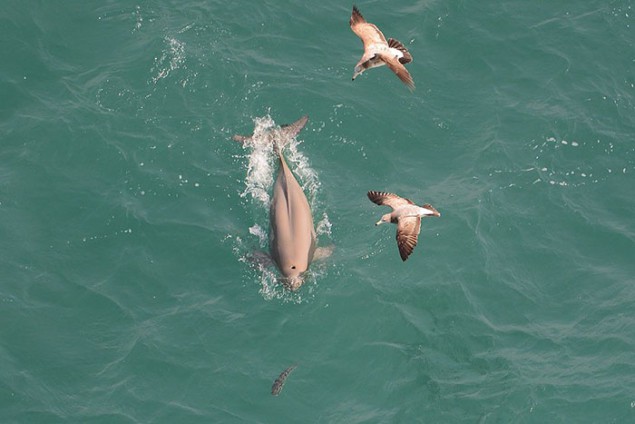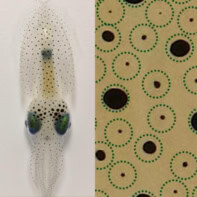
A porpoise’s forehead acts like a ‘metamaterial’ to create the directional sound beam used by the marine mammals to detect and track prey, claim researchers in the US and China. The acoustics experts and biologists also found that the animals can adjust the acoustic properties of their foreheads to control the width of the beam. They believe that the structure of the porpoise forehead could inspire the development of new materials to control sound, with applications in underwater sonar and ultrasonic imaging.
Porpoises are toothed whales that use directional acoustic waves as a sonar system to hunt. When first searching for prey they use a narrow beam of sound to scan the water. But as they close in on a target they dramatically increase the width of the beam, to keep it in their field of view.
Scientists have struggled to understand how porpoises produce, and control, this directional echolocation beam. Porpoises produce the sounds, or ‘clicks’, by forcing air through a structure in their blowhole called the phonic lips. But this sound source is smaller than the wavelength of the sound it produces, which should, in theory, make the acoustic beam hard to control. And the phonic lips emit sound in all directions, not just forwards.
Sound velocity
To investigate these issues, Wenwu Cao, at Pennsylvania State University, and colleagues took computed tomography (CT) scans of a dead, finless porpoise (Neophocaena phocaenoides) and used ultrasound to measure the sound velocity of the different tissues in its head. They combined this information with field recordings of porpoise clicks and built a mathematical model to simulate sonar emission and beam control.
They found that air sacs in the head and the porpoise’s skull and melon – a tissue bulge on the forehead – all work together to direct the sound. When they included an omnidirectional sound source in their model of the porpoise forehead, a sharp beam of sound was formed with an angular width of 13°. “The forehead structure forms a specially designed passage for the produced wave signal and forces the beam to go forward,” Cao told Physics World.
The air sacs have the lowest sound velocity and the skull has the highest, but they both work as sound reflectors guiding the sound forwards. The melon comprises a low-velocity core enclosed in high-velocity connective tissues. These different acoustic properties achieve the focussing effect.
Acoustic lens
Further modelling showed that changing the shape of the melon and air sacs, by compressing the soft tissues of the forehead, increased the width of the beam to almost 20°. In effect, the melon acts as an acoustic lens that can be adjusted by the porpoise’s facial muscles. And porpoises have been observed doing just that.
A previous study of harbour porpoises found that as they approach prey the width of their echolocation beam changes from 9° to 15°. Further video and magnetic resonance imaging showed that during this period the porpoise’s melon rapidly changes shape, controlled by a network of facial muscles.
By compressing the forehead, the beam can be widened, so that the fish is always on the sonar screen,”
Wenwu Cao, Pennsylvania State University
The initial narrow beam allows porpoises to locate distant fish, but because the field of view is narrow, the fish may move out of sight when they close in, Cao explains. “By compressing the forehead, the beam can be widened, so that the fish is always on the sonar screen.”
Cao says that although it has not been observed, it is reasonable to speculate that other cetaceans – whales, dolphins and porpoises – “may use the same principle to control their acoustic beam since their biosonar systems are similar”.
Ultrasound expert Bruce Drinkwater at the University of Bristol, told Physics World: “They show convincingly that the acoustic properties of the melon cause the sound to be focused into a well-directed beam. It is fascinating to see that evolution has come up with a solution that is quite complex and unlike anything humans have “invented” – the precise shape of the melon is important, as is the distribution of speed of sound.”
“The idea of a sonar system that manipulates sound by deforming an engineered melon is a nice one,” adds Drinkwater. Currently, beam control for underwater sound is achieved using complex and expensive programmable arrays of speakers, he explains. A porpoise-like solution that used a single source of sound and a “melon” could be cheaper. “Change the shape of the melon and the beam is moved or focused.”
The research will be described in Physical Review Applied and an abstract is available.



